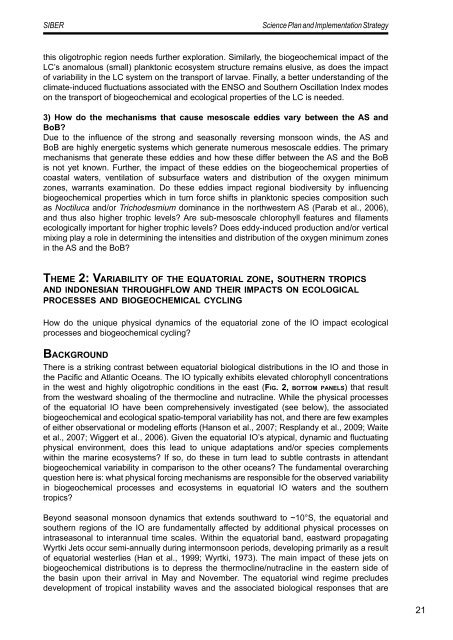SIBER SPIS sept 2011.pdf - IMBER
SIBER SPIS sept 2011.pdf - IMBER
SIBER SPIS sept 2011.pdf - IMBER
You also want an ePaper? Increase the reach of your titles
YUMPU automatically turns print PDFs into web optimized ePapers that Google loves.
<strong>SIBER</strong><br />
Science Plan and Implementation Strategy<br />
this oligotrophic region needs further exploration. Similarly, the biogeochemical impact of the<br />
LC’s anomalous (small) planktonic ecosystem structure remains elusive, as does the impact<br />
of variability in the LC system on the transport of larvae. Finally, a better understanding of the<br />
climate-induced fluctuations associated with the ENSO and Southern Oscillation Index modes<br />
on the transport of biogeochemical and ecological properties of the LC is needed.<br />
3) How do the mechanisms that cause mesoscale eddies vary between the AS and<br />
BoB<br />
Due to the influence of the strong and seasonally reversing monsoon winds, the AS and<br />
BoB are highly energetic systems which generate numerous mesoscale eddies. The primary<br />
mechanisms that generate these eddies and how these differ between the AS and the BoB<br />
is not yet known. Further, the impact of these eddies on the biogeochemical properties of<br />
coastal waters, ventilation of subsurface waters and distribution of the oxygen minimum<br />
zones, warrants examination. Do these eddies impact regional biodiversity by influencing<br />
biogeochemical properties which in turn force shifts in planktonic species composition such<br />
as Noctiluca and/or Trichodesmium dominance in the northwestern AS (Parab et al., 2006),<br />
and thus also higher trophic levels Are sub-mesoscale chlorophyll features and filaments<br />
ecologically important for higher trophic levels Does eddy-induced production and/or vertical<br />
mixing play a role in determining the intensities and distribution of the oxygen minimum zones<br />
in the AS and the BoB<br />
Th e m e 2: Va r i ab i l i t y o f t h e e q u a t o r i a l z o n e, s o u t h e r n t r o p i cs<br />
a n d i n d o n es i a n t h r o u g h f l o w a n d t h e i r i m p a c ts o n e c o l o g i c a l<br />
p r o c e s s e s a n d b i o g e o c h e m i c a l c y c l i n g<br />
How do the unique physical dynamics of the equatorial zone of the IO impact ecological<br />
processes and biogeochemical cycling<br />
Ba c k g r o u n d<br />
There is a striking contrast between equatorial biological distributions in the IO and those in<br />
the Pacific and Atlantic Oceans. The IO typically exhibits elevated chlorophyll concentrations<br />
in the west and highly oligotrophic conditions in the east (Fig. 2, b o t t o m p a n e l s) that result<br />
from the westward shoaling of the thermocline and nutracline. While the physical processes<br />
of the equatorial IO have been comprehensively investigated (see below), the associated<br />
biogeochemical and ecological spatio-temporal variability has not, and there are few examples<br />
of either observational or modeling efforts (Hanson et al., 2007; Resplandy et al., 2009; Waite<br />
et al., 2007; Wiggert et al., 2006). Given the equatorial IO’s atypical, dynamic and fluctuating<br />
physical environment, does this lead to unique adaptations and/or species complements<br />
within the marine ecosystems If so, do these in turn lead to subtle contrasts in attendant<br />
biogeochemical variability in comparison to the other oceans The fundamental overarching<br />
question here is: what physical forcing mechanisms are responsible for the observed variability<br />
in biogeochemical processes and ecosystems in equatorial IO waters and the southern<br />
tropics<br />
Beyond seasonal monsoon dynamics that extends southward to ~10°S, the equatorial and<br />
southern regions of the IO are fundamentally affected by additional physical processes on<br />
intraseasonal to interannual time scales. Within the equatorial band, eastward propagating<br />
Wyrtki Jets occur semi-annually during intermonsoon periods, developing primarily as a result<br />
of equatorial westerlies (Han et al., 1999; Wyrtki, 1973). The main impact of these jets on<br />
biogeochemical distributions is to depress the thermocline/nutracline in the eastern side of<br />
the basin upon their arrival in May and November. The equatorial wind regime precludes<br />
development of tropical instability waves and the associated biological responses that are<br />
21












